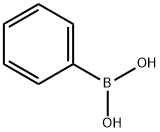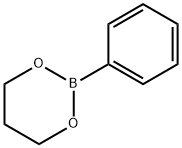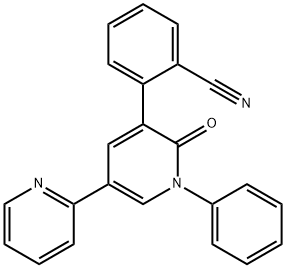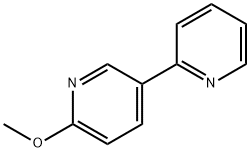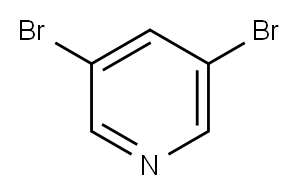Phenylboronic acid (contains varying amounts of Anhydride) , 97% , 98-80-6
Synonym(s):
Benzeneboronic acid;Dihydroxyphenylborane;Phenylboric acid;Phenyl-boric acid;Phenyldihydroxyborane
CAS NO.:98-80-6
Empirical Formula: C6H7BO2
Molecular Weight: 121.93
MDL number: MFCD00002103
EINECS: 202-701-9
| Pack Size | Price | Stock | Quantity |
| 5G | RMB24.00 | In Stock |
|
| 10G | RMB42.40 | In Stock |
|
| 25G | RMB79.20 | In Stock |
|
| 50G | RMB135.20 | In Stock |
|
| 100G | RMB239.20 | In Stock |
|
| 250G | RMB503.20 | In Stock |
|
| 1kg | RMB1887.20 | In Stock |
|
| others | Enquire |
PRODUCT Properties
| Melting point: | 216-219 °C(lit.) |
| Boiling point: | 265.9±23.0 °C(Predicted) |
| Density | 1.13±0.1 g/cm3(Predicted) |
| storage temp. | Keep in dark place,Sealed in dry,Room Temperature |
| solubility | Chloroform (Slightly), DMSO (Slightly), Methanol (Slightly) |
| form | Crystalline Powder |
| pka | 8.83(at 25℃) |
| color | White to off-white |
| Water Solubility | 10 g/L (20 ºC) |
| Sensitive | Hygroscopic |
| Merck | 14,1068 |
| BRN | 970972 |
| Stability: | Hygroscopic |
| InChIKey | HXITXNWTGFUOAU-UHFFFAOYSA-N |
| CAS DataBase Reference | 98-80-6(CAS DataBase Reference) |
| EPA Substance Registry System | Boronic acid, phenyl- (98-80-6) |
Description and Uses
Phenylboronic Acid is a compound used in organic synthesis of various pharmaceutical goods.
Phenylboronic acid (PBA) and its derivatives can bind sugars and other diol compounds to form cyclic boronate esters. These esters bear negative charges. Due to this reaction, sugars can be detected by means of electrochemical and optical techniques.
PBA modified electrodes have been constructed as reagentless electrochemical sensors. There, PBA is absorbed on the electrode surface either as a self- assembled monolayer film ore a polymer thin film. Basically, for optical detection techniques for the detection of sugars, PBA is modified with a chromophore that should change its properties on reaction with a sugar.
Reaction of Phenylboronic acid with a sugar
Safety
| Symbol(GHS) |  GHS07 |
| Signal word | Warning |
| Hazard statements | H302 |
| Precautionary statements | P264-P270-P301+P312-P501 |
| Hazard Codes | Xn,Xi,N |
| Risk Statements | 22-36/37/38-20/21/22 |
| Safety Statements | 22-24/25-36/37/39-26-36 |
| WGK Germany | 3 |
| RTECS | CY8575000 |
| Hazard Note | Harmful |
| TSCA | Yes |
| HazardClass | IRRITANT, MOISTURE SENSITIVE |
| HS Code | 29310095 |
| Toxicity | LD50 orl-rat: 740 mg/kg 14KTAK -,693,64 |

